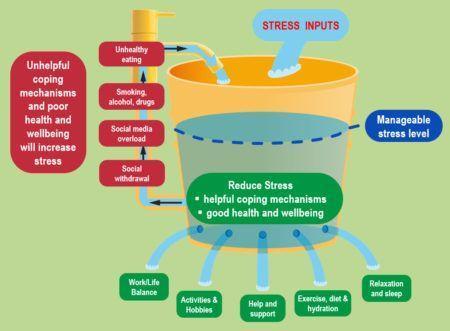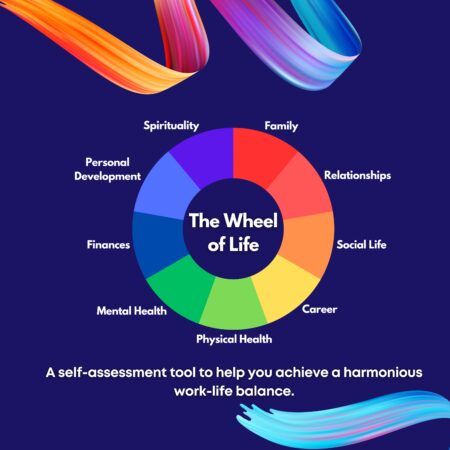Remember Julia? In Part 1 of this blog post series, we met Julia, who didn’t know how to balance her work life with her home life – indeed, she had no idea how to even begin trying.
For the sake of her mental and physical health, Julia needed to build clearer boundaries between her work and home life to stop work from seeping into the time she should be relaxing.

To do this, she identified the parts of her life that were causing her stress and anxiety. A key area was work communications which came in outside of working hours, including emails, messages, and phone calls. After detecting this, she realised she needed to communicate with her colleagues so they understood her working needs and respected her office hours. This meant she could stop working overtime and leave work behind for the evening at the right time. As a result, she found she had time to look after her physical health and wellbeing by cooking nourishing food, seeing friends and family, and exercising regularly. Balancing her work life and home life allowed her to turn her life around and feel much happier and healthier in the long term.
But what measures did Julia take to get to this point? In Part 2 of this series, you can learn how a healthy work-life balance can be regained, making way for a more fulfilling, calmer life, just like Julia.
Where to start:
4 Top Tips for balancing work and home life

1. Focus on physical and emotional health and wellbeing
- Eat a healthy, balanced diet full of vitamins and minerals and plenty of proteins and fibre. With every meal, you can use the ‘rainbow trick’. This involves making sure each plate of food contains a variety of different coloured foods (plenty of fruit and veg!), ensuring you’re getting essential nutrients into your diet everyday. [Ref 1]
- Stay hydrated and aim to drink around 2-3 litres of water everyday so that your body can function at its best.
- Exercise regularly to reduce stress and boost your energy levels.
- Aim for at least seven hours of sleep every night and establish a regular sleep routine. You should avoid consuming caffeine towards the latter half of the day and limit the use of screens before bedtime to ensure that you get a good rest.[Ref 2]
- Perform short, meditative exercises. This could include using your senses to ground yourself in the present, thinking about what you can smell, touch, taste, see, and hear. You could also practice deep breathing exercises.[Ref 3] For example, you could have a go at the 4-7-8 breathing technique: breathe in for 4 seconds, hold your breath for 7, and exhale for 8.[Ref 4] Feel your stress melt away.
- Follow your passions and pursue activities you enjoy, finding ways to integrate them into your daily life. E.g., At lunchtime, you might go for a short walk around the block, do a quick yoga stretching session, or listen to a chapter of an audiobook.
2. Break unhealthy habits that may dominate your life
- Drop activities that drain your time or energy. This could include limiting the amount of time you spend watching TV, playing video games, or mindlessly scrolling.
- Learn to say no and be selective and cognisant about your commitments, being careful not to overcommit yourself. Do what makes you happy and say no to anything that drains you or negatively affects your physical or emotional wellbeing.
- Be mindful of any tendencies to stress eat or eat sugary, fatty snacks to boost your energy when you’re feeling unmotivated or tired.


3. Improve your time management skills
- Be aware of your peak productivity hours and use them to your advantage. When do you work best?
- Once you’ve identified your most productive hours, you should structure your day to tackle important and urgent tasks during these times. You can use the Eisenhower Principle to do this, categorising and completing tasks based on their urgency and importance.[Ref 5 & 6]
The Eisenhower Principle is a time management technique that helps you prioritise tasks based on their importance and urgency. It involves categorising tasks into four quadrants: urgent and important tasks, important but not urgent tasks, urgent but not important tasks, and neither urgent nor important tasks. By categorising tasks into these quadrants, individuals can utilise their time and attention more effectively.
- Categorise your emails based on priority and urgency – you could flag or mark your inbox’s contents to make this more visual. It might also be wise to set boundaries with your co-workers, ensuring that your focus times aren’t interrupted by a bombardment of communications that break your flow and make it tricky for you to complete tasks. Perhaps you would benefit from factoring in a designated time everyday to respond to emails and calls.
- Control meetings and limit their time to ensure they are productive and do not consume too much of the day. Plan the points you need to discuss and don’t waste time – focus on each one clearly and concisely, aiming to leave meetings feeling like you’ve tackled exactly what you came in for.
- Schedule downtime and take breaks during the working day. It could be something as simple as walking 100 steps or stretching out. This will help you maintain your focus and productivity levels.
- At the end of each working day, perform a self-analysis. What went well? What do you need to improve? How can you make these adjustments? This can stop your working hours from going awry, detecting any snags before they snowball and cause you stress or tension that’s hard to unpick.
4. Focus on healthy social interactions
- Where family and friends are concerned, focusing on quality time is essential. Make the most of your weekends and holidays by catching up with them and doing activities you all enjoy together. Taking a decent break at the weekends will help you to return to your work feeling refreshed and motivated to power through your to-do list and feel more on top of things.
- Being constantly connected can be overwhelming. Be conscious about when and how you use social media. If you think that it’s taking up too much of your time or affecting you negatively, reduce how often you go online – usage limits on specific apps can help with this, as can adjusting your phone’s ‘focus’ or ‘downtime’ settings.

Begin to curate your work-life balance with a step-by-step approach
- To cultivate a work-life balance, you should start small and build from this point.
- First of all, assess your current work-life balance. To do this, you should take a bird’s eye view of your life, considering aspects like physical and emotional wellbeing, relationships, work, and leisure time. Then you can look at how they interact (or interfere!) with your work-life balance.
- While assessing your work-life balance, you can also identify your ‘stress bucket’[Ref 7] – a simple exercise which can help you recognise those activities or situations that contribute most to your stress levels.
- You can combine these practices with the ‘wheel of life’[Ref 8] – an extremely valuable tool for assessing your current work-life balance and comparing this with your idea of an ideal work-life balance.
Stress Bucket
Picture having a bucket which fills up as you encounter various stressors. You carry it around with you, and when you experience significant levels of stress, the bucket quickly fills up. Sometimes, you’ll feel inundated by everything, and your bucket will threaten to overspill, but on other days, you may feel better equipped to handle it. This bucket is called the stress bucket.
The Wheel of Life
The wheel of life is a self-assessment tool that evaluates the current balance of different aspects of your life, assisting you in achieving a harmonious work-life balance. This circular diagram represents the critical components of your life, resembling the spokes of a wheel. These include:
• Family & Home life
• Health & Wellbeing
• Career
• Finances
- To get a realistic picture of your work-life balance, it can also be helpful to take a closer look at a few days which represent your typical week. These can form a base from which you can start to make positive changes.
- If you’re struggling with your work-life balance, it always helps to talk to someone about how you’re feeling and how your work-life balance (or lack of one) is impacting your wellbeing. This could be a work mentor, family member, trusted friend, or colleague. Other people might offer you new insights and perspectives on your work-life balance that you might find helpful.
- Using these exercises as a starting point, you can begin to make conscious and deliberate changes to your lifestyle that support you in your quest to secure a healthy work-life balance.
Above all, however, you should accept that no one is perfect, and making mistakes is normal.
Remember, aiming for a good work-life balance is a PROCESS, not a one-time fix!
Achieving a work-life balance is a continuous cycle that requires constant efforts and adjustments as time goes on.[Ref 8] It is also important to remember that it is not always possible to have a perfect work-life balance as unforeseen circumstances emerge at every step in our lives. Nothing is predictable, so it’s essential to expect the unexpected and focus on being adaptable and kind to yourself. This will give you the confidence to try new things personally and professionally, helping you lead a well-rounded, fulfilling life.
When balancing the personal and the professional, we must also focus on making enriching connections and being intentional about how we spend our time. Whether it’s a day at the office or leisure time at home or with friends, organising your time, setting boundaries, and having meaningful experiences that create a sense of harmony across all aspects of life is so important.
So go ahead, remember Julia’s experience, and make the changes you need to improve your work-life balance. You’ll quickly see the positive impact it has on your overall health and wellbeing!
References & External Links
- Eating the Rainbow — Is It Useful and Should You Try It?, Healthline.
- 7 hacks for better sleep, University of Colorado.
- Breathing Techniques for Stress Relief, WebMD.
- www.medicalnewstoday.com/articles/324417
- Rick Hughes, ‘Get a Life!’.
- Ellen Auster and Shannon Auster-Weiss, ‘Conquer Your To-Do List with This Simple Hack’, Harvard Business Review.
- www.phoenixhealthandwellbeing.org.uk/the-stress-bucket/
- www.indeed.com/career-advice/career-development/wheel-of-life
- Iona Lupu and Mayra Ruiz-Castro, ‘Work-Life Balance Is a Cycle, Not an Achievement’, Harvard Business Review.
- “Seven Steps to Running”, Lloyd’s Wellbeing Centre Blog – www.lloydswellbeingcentre.co.uk/blog/seven-steps-to-running/
- “6 Tips for Better Work-Life Balance”, Forbes – www.forbes.com/sites/deborahlee/2014/10/20/6-tips-for-better-work-life-balance/
- “Here’s How the Eisenhower Matrix Helps You Manage Tasks Better”, LinkedIn – www.linkedin.com/pulse/heres-how-eisenhower-matrix-helps-you-manage-tasks-better-anand/
- “What is the Wheel of Life and How Does it Apply to You?”, Indeed – https://uk.indeed.com/career-advice/career-development/wheel-of-life
- “The Stress Bucket”, Mental Health UK – https://mentalhealth-uk.org/blog/the-stress-bucket/
- “Sleep Tips: 6 Steps to Better Sleep”, Mayo Clinic – www.mayoclinic.org/healthy-lifestyle/adult-health/in-depth/sleep/art-20048379
- “When You Should (and Shouldn’t) Check Your Email”, Top Resume – www.topresume.com/career-advice/when-you-should-and-shouldnt-check-your-email#:~:text=Similar%20to%20how%20you%20block,on%20the%20task%20at%20hand
Please note, these are external links away from the Thrive4Life website. We are not responsible for the content of external websites.












